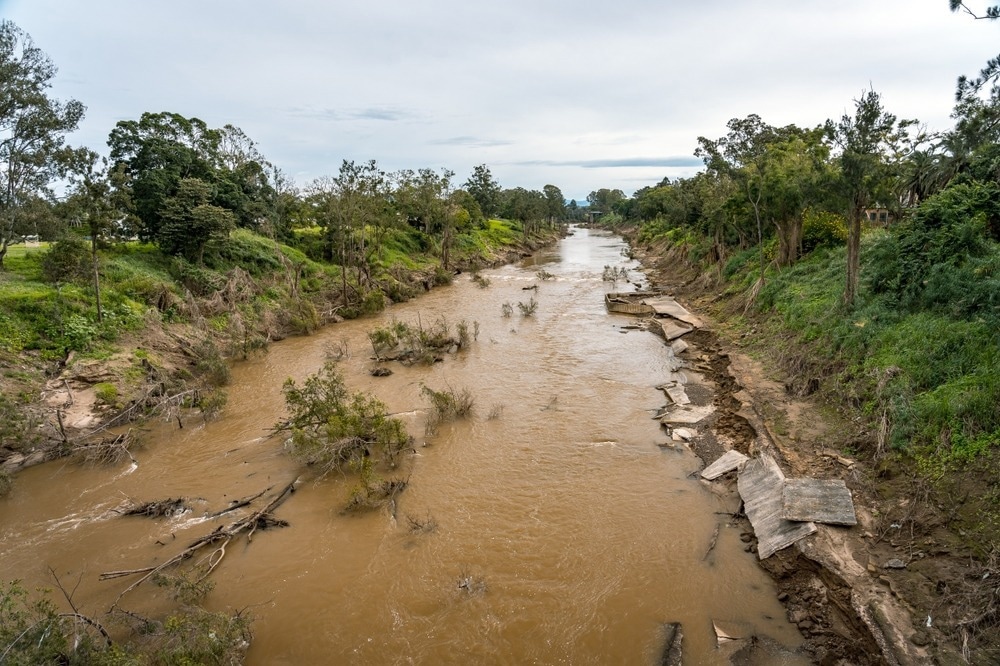Unusual rainfall events caused severe floods in rural and urban New South Wales and Southeast Queensland during the Australian summer of 2022. A recent study published in Remote Sensing uses VIIRS night-time light brightness imagery to map the extent of flooding in Brisbane and assess the change in energy utilization for the flood effect.
Study: Assessing the 2022 Flood Impacts in Queensland Combining Daytime and Night-time light Optical and Imaging Radar Data. Image Credit: Alex Cimbal/Shutterstock.com
The researchers established the normalized difference inundation index (NDII) using a novel spectral measure based on variations in the NIR reflectance owing to sediment-laden flood waters. They used pre-flood and peak-flood Planet-Scope images to map the inundated areas. Planet-Scope mapping of the inundated areas was derived from the Capella-Space X-band/HH imaging radar data collected at peak flood date.
Using a single-date radar image partially scattered by the tree canopy and the SAR look angle preventing the satellite from observing flooded streets contribute to omission inaccuracies. The researchers could locate grid cells where electricity use was influenced by floods using VIIRS night-time light imagery.
Remote Sensing Technology for Flood Sensing
The mapping of damage caused by severe events is now a regular practice. These events are natural disasters such as fires, earthquakes, floods, volcanic eruptions, or human-made disasters.
Remote sensing mapping of floods is used to map inundated areas with high spatial resolution optical images being the most successful method. Remote sensing is also used to map building and property damage from floods, with imaging radar data being the most effective method.
Owing to its capacity to pierce through cloud cover and dense forest, imaging radar is best suited to map the inundated area.
Available Datasets for Flooding Events
The International Charter for Space and Major Disasters, which will have 17 charter members by 2022, was founded in 1999 to provide emergency assistance to nations in need. A total of 405 activations out of 765 activations worldwide are associated with flooding occurrences, demonstrating the severity, frequency, and societal effects of floods.
The MODIS-NRT-FLOOD, which has a spatial resolution of 250 m, and the UNO-SAT Flood Portal, which offers vector flood maps for selected flood occurrences utilizing different satellites, are two worldwide-accessible flood datasets. The Dartmouth Flood Observatory used MODIS imagery to create maps of 913 significant flood events between 2000 and 2018. These datasets are available in the global flood database on Google Earth Engine. A new flood water fraction product based on the VIIRS sensor is also accessible with a spatial resolution of 375 m.
Limitations of Current Datasets for Flood Events
Flood mapping is one of the primary focuses of the European Union's newly built Copernicus Emergency Management Service (CEMS).
The MODIS and VIIRS flood products rely on optical imagery and coarse spatial resolution. Cloud cover impacts their mapping, making them insufficient for short-term and relatively minor urban flood events.
Merging of Optical and Imaging Radar Sensors for Better Flood Mapping
European Union Sentinel-1 SAR satellites can provide flood mapping outputs with a spatial resolution of 20 m. The merging of optical and imaging radar data can improve the mapping of surface reference water covers to improve flood mapping products. The temporal return time is crucial for mapping inundated areas because flooded areas often only remain underwater for a few hours to days (apart from seasonal floodplains).
Development of Optical and Radar Sensors with Night-time Light Imagery for Flood Mapping
In Australia, the Water Observation from Space product provides the annual water cover mapping based on the Landsat image collection. This product, while admirable, is not well suited for mapping areas that were briefly underwater due to the relatively short Landsat revisit time. Volunteer passenger images taken from aircraft can be used as an additional source for flood mapping, but this is not a practical choice.
A suitable method for tracking human activity from space is remote sensing of night-time light, which is also used to track how natural and human-made disasters affect energy availability.
Levin et al. demonstrated the collective use of night-time light imagery and high-resolution spatial daytime optical imagery to assess the effect of flood events in northern New South Wales (NSW) and southeast Queensland (SEQ), Australia. This was due to the limitations of currently available flood products. The researchers used the nightly VIIRS Black Marble product of VNP46A1 to analyze how flood events affected artificial night-time lights.
Research Finding
Floods are a frequent and essential threat both internationally and in Australia. Monitoring inundation in urban settings presents unique challenges that call for frequent sensor revisits (at least twice daily) owing to the shorter length and smaller geographic scope of flood episodes.
The effects of floods on energy access can be tracked using VIIRS night-time light brightness images. In this research, the researchers demonstrated that a multi-sensor strategy is helpful when dealing with complicated natural disaster situations because diverse sensors validate one another and follow various elements of unfolding events.
Reference
Levin, N., & Phinn, S. (2022) Assessing the 2022 Flood Impacts in Queensland Combining Daytime and Night-time light Optical and Imaging Radar Data. Remote Sensing, 14(19), Article 19. https://www.mdpi.com/2072-4292/14/19/5009/htm









 Add Category
Add Category


